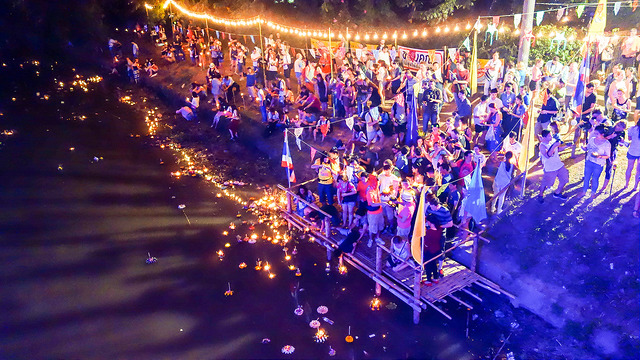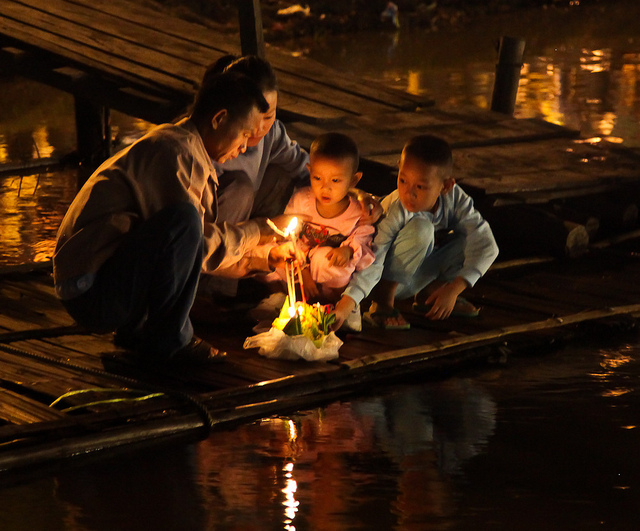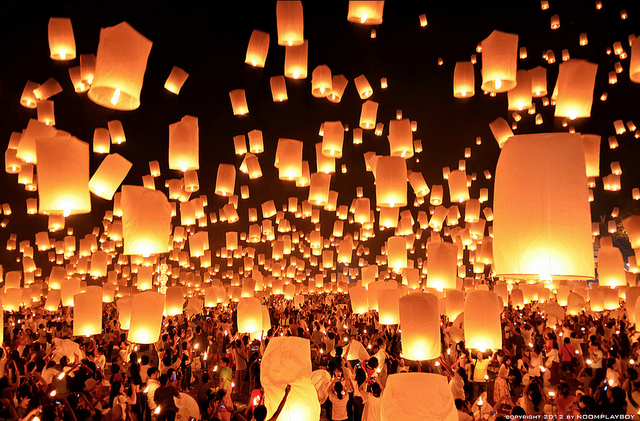Loi Krathong and Yi Peng – Two Thai Festivals Posted by sasha on Nov 14, 2016 in Uncategorized
While the news out of Thailand hasn’t exactly been great this year – problems with the government and the recent passing of the beloved King Bhumibol – there is a bright spot in the country today. As a matter of fact, there are thousands of them. That’s because it’s Loi Krathong (ลอยกระทง loi grà-tong), or the “floating basket festival.” It’s also Yi Peng (ยี่เป็ง yêe pen) in the north, or the “floating lantern festival.” Let’s learn a bit about these traditional Thai holidays and how they’re celebrated.
Background
The origins of the holiday are not exactly known. Some believe it began in the Sukhothai period after a beautiful woman named Nang Nopphamat tried to attract the attention of King Ramkamhaeng by floating a colorful lotus-shaped offering down the river to him. This legend accounts for the krathong – the floating baskets that are a staple of the festival. According to King Rama IV, the holiday is meant to honor the Buddha. It’s also seen as a chance to show thanks to the Hindu goddess of water Gangga, known as Phra Mae Khongkha (พระแม่คงคา prá mâe kong-kaa) in Thai. Sending off the krathong also symbolizes starting anew, much in the way New Year’s does in the west. It’s a way to rid yourself of bad luck and misfortune and look ahead to a fresh start. In another similarity to Western New Year, many people view the holiday simply as a chance to let loose and party. With fireworks, parades, and beauty contests, there’s plenty of fun to be had. The festival falls on the eve of the 12th full moon in the traditional Thai lunar calendar, so it’s different every year.
Krathong – The Floating Baskets
Traditionally, the krathong baskets were made from pieces of banana tree trunks or spider lily plants. These days many people make them out of bread, which can then serve as an offering to the fish and the river goddess. Some have taken to using styrofoam, but thankfully that’s being banned in most places due to the pollution it causes. Typically, a krathong will hold a single candle, incense, flowers, and coins. You might even see a strand of hair or nail clippings in one. These are meant to get rid of bad luck or misfortune. Some are very simple while others can be rather complex. If you’re not sure how to make them yourselves, you can easily purchase them all across the country. On the night of the full moon, people send their krathong off in a body of water. Apparently your wish will only come true if the candle stays lit until it’s out of sight, so let’s hope your krathong doesn’t flip over as soon as you put it in the water!
For more on this exciting Thai festival, check out this great video from last year’s celebrations courtesy of iTravel Channel:
Yi Peng – Floating Lanterns
Up in the north, Loi Krathong coincides with a traditional Lanna holiday – Yi Peng (ยี่เป็ง yêe pen) – yi meaning “two” and peng meaning “full moon.” If you couldn’t guess, this festival falls on the full moon of the 2nd month according to the Lanna calendar. The highlight of this holiday is the releasing of thousands of lanterns known as khom loi (คมลอย kom loi) into the sky. See this amazing spectacle in this short video from Just One Way Ticket:
While the celebrations are definitely toned down this year as the entire country is in a one-year mourning period following the passing of the king, look for it to make a triumphant return next year.

Build vocabulary, practice pronunciation, and more with Transparent Language Online. Available anytime, anywhere, on any device.
About the Author: sasha
Sasha is an English teacher, writer, photographer, and videographer from the great state of Michigan. Upon graduating from Michigan State University, he moved to China and spent 5+ years living, working, studying, and traveling there. He also studied Indonesian Language & Culture in Bali for a year. He and his wife run the travel blog Grateful Gypsies, and they're currently trying the digital nomad lifestyle across Latin America.






